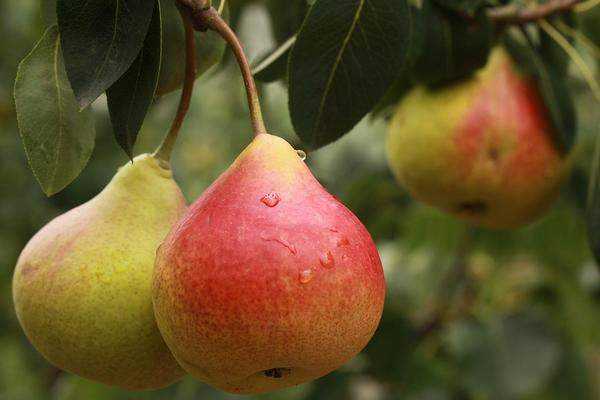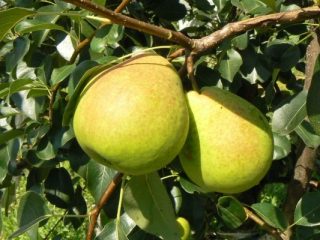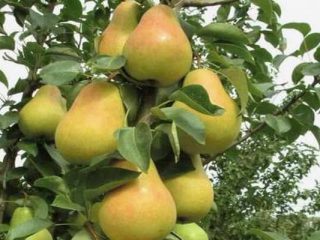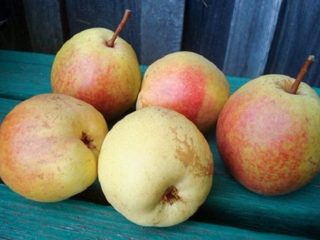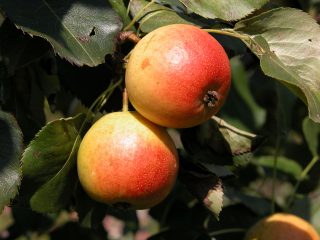Content
Winter varieties of pears have a high keeping quality. The crop can be stored for more than three months. Such varieties are frost-resistant and unpretentious in care. Description, photos and reviews of pear New Year's - important information, after reading which, no connoisseur of tasty fruits will remain indifferent. The New Year's pear variety is valued for its regular fruiting, scab resistance, and minimal maintenance requirements.
Description of the pear variety New Year
Pear New Year was bred in 2016 by domestic breeders from the city of Bryansk. The variety is high-yielding, tolerates sharp changes in weather conditions, and has an average resistance to diseases. The first fruits can be obtained 5 years after planting the tree. The harvest period is from September to October.
The variety differs from other types of pear seedlings. Medium-sized tree, fruiting in large pears. The crown is wide, slightly spreading. The bark is rough, gray in color. Branches are brown, slightly pubescent, arched.
The leaves are rounded, slightly wide, the color is deep green. Over time, the green mass can form small curls around the edges of the leaves.
Fruit characteristics
The fruits of the New Year's pear are rather large, pear-shaped. Weight from 100 to 150 g. The color is green-olive with a raspberry tinge. After harvesting, pears can be stored for more than 3 months.
The pulp of a New Year's pear is juicy, white. The taste is sweet with a slight sourness, the aroma is rich. The fruits have small seed chambers and a rough skin.
Pros and cons of the New Year variety
Among the advantages of the New Year's pear variety, it should be noted:
- pleasant fruit taste;
- frost resistance;
- high yield rate;
- medium resistance to diseases and insect pests;
- increased scab resistance;
- long shelf life;
- attractive fruit appearance;
- winter ripening period.
It should be noted that the variety has practically no drawbacks in cultivation. The only point: with abundant fruiting, the fruits differ in size, but this minus practically does not bother gardeners.
Optimal growing conditions
This variety is recommended for growing in temperate climates, preferably cultivation in Central Russia. The New Year's pear has high frost resistance, it can be for a long time without watering.
If you plan to grow a fruit tree in the south, it is important to determine the correct time for planting. In places with very hot summers, it is recommended to plant a New Year's pear in early spring. In all other cases, seedlings are planted in the fall, but before the onset of frost. The best time to do this: late September - early October. If you plant in the spring, the optimal time would be late April - early May.
Planting and caring for a New Year's pear
Before you start planting a tree, you must choose the right place. It is preferable that the site be free of drafts, well lit by the sun.It is better to plant a New Year's pear from the south side. The groundwater depth should not exceed 2 m.
The site for planting is being prepared in the fall. Even if the planting will be carried out in the spring, site preparation should be done in advance. To do this, dig holes up to 50 cm deep, up to 1 m wide. A prepared soil mixture is laid on the bottom of the planting pit, consisting of: superphosphate, humus, fertile soil. All components are mixed in equal proportions.
After preparing the planting pit, a strong support should be installed. To do this, take a high wooden peg. The soil at the bottom of the planting hole is loosened well, small holes are made, which will improve the exchange of air, which will stimulate the active growth of the tree root.
Landing rules
Having performed the correct agricultural technique for planting New Year's pears, you can minimize the risk that the seedling will not take root.
Step by step guide:
- Prepare the seedling. A small pruning of the roots and upper part of a young sprout is done. After that, the seedling is placed in water.
- Wood ash is poured into the ground dug from the hole, a little water is added.
- The root of the plant is placed in the prepared mixture.
- A dozen raw eggs are laid at the bottom of the planting pit, and a mixture of ash and earth is poured on top.
- Place the seedling in the hole, leaving the root collar above ground level.
- They fill the hole with soil with a slide, tamping well.
- A dozen raw eggs are laid around the trunk, covered with earth.
- The top of the cut is lubricated with a composition of earth with wood ash.
- Tie the seedling to the support.
- Watering is carried out (20 liters of water).
- Mulching is carried out with peat or sawdust.
Watering and feeding
After planting a young seedling, it is important to provide the plant with proper care.
Winter New Year's pear loves moisture, but without an excess. The best watering is rain. In the absence of precipitation for a long time, watering is carried out manually.
Experienced gardeners recommend digging a ditch (10 cm wide) near the pear, where water is poured if necessary. Thus, the root system of the tree will absorb as much moisture as it needs.
In order for the New Year's pear to bring a good harvest, top dressing is performed if necessary. You can determine what the plant needs by the appearance of the tree:
- with a lack of nitrogen, the green mass develops poorly;
- an excess of nitrogen is indicated by a long ripening period of fruits and low frost resistance;
- lack of phosphorus can be determined by breaking off branches at the bottom of the tree;
- potassium deficiency is characterized by discoloration of the leaves and their drying;
- lack of calcium manifests itself in spots on the leaves and leads to early fall of foliage.
According to gardeners, the New Year's pear should be fed closer to autumn. The seedling will better tolerate frosts, and the soil will be saturated with useful substances. It is worth noting that feeding is performed after harvesting the fruits.
Pruning
Trees are pruned in autumn and spring. This activity improves the quality and quantity of the fruit. Regular pruning allows the green mass to receive more sunlight. Spring shoot removal is a good prevention of diseases and insect pests.
To properly trim, you must follow the instructions:
- Choose a garden tool according to the age of the plant. Young trees are cut with pruning shears, adults - with a hacksaw.
- The main trunk is shortened by ¼ part, poorly developed and dead shoots are removed.
- Pruning is carried out at a temperature not lower than 5-7 degrees Celsius.
- Places of cuts are treated with a special composition: oil paint, drying oil, garden varnish or the preparation "Rannet".
Whitewash
Whitewashing of New Year's pears is carried out annually in autumn and early spring. Autumn whitewashing helps to minimize the risk of damage to the main trunk, and is the prevention of diseases. The trunk and main branches are subject to whitewashing.
To perform this event, use:
- lime powder - 2.5 kg;
- copper sulfate 0.5 kg;
- wood glue - 1 pack;
- any insecticide - 1 pack;
- water - 12 liters.
All components are mixed and left for several hours until complete dissolution.
Trees are treated with the prepared composition, with a deepening into the ground by 4-5 cm.
Preparing for winter
Main care measures: preventive pruning of old, damaged branches, whitewashing, fertilization.
Closer to winter, phosphorus-potassium fertilizers are applied under the trees, and the area is cleared of weeds. It will be useful to add superphosphate and potassium sulfate to the soil. Such dressings will provide the pear with useful substances for the entire winter.
Do not forget about protection from rodents. Mice and hares can damage the bark of young trees. To avoid unpleasant consequences, the trunk is wrapped in burlap. Experienced gardeners recommend lubricating the bark of a tree with clay mixed with mullein and plain water. In this case, you can do without shelter.
Pollination
With the presence of pollinators in the garden, the yield and quality of the fruit are increased. Pear Severyanka is the best pollinator for most pear varieties.
Yield
The ripeness of the fruit can be determined by the following criteria:
- the peel of the pear is green with a raspberry tint;
- fruits are easily removed from the branches;
- pleasant taste, white pulp.
New Year's pear yields a harvest at the end of September; it is harvested until mid-October. A more precise assembly period is determined individually, depending on the growing region.
After harvest, it is recommended to store the fruit in a cool, dark place.
Diseases and pests
This variety has an average resistance to diseases and insects. If you identify and identify the pathogen in time, you can quickly cope with the disease.
For the New Year's pear, aphids, moths, pear mites, fruit rot and black crayfish are dangerous. The main advantage of the variety is scab resistance.
If a tree is damaged by one of the diseases, you should purchase special preparations in a garden store, process according to the instructions.
Reviews about pear New Year
Conclusion
Having looked at the description, photos and reviews about the New Year's pear, it can be noted that the fruit tree is absolutely unpretentious in care. The variety is frost-resistant, can withstand prolonged absence of watering. The New Year's pear has an average susceptibility to diseases and insect pests, but is resistant to scab.
